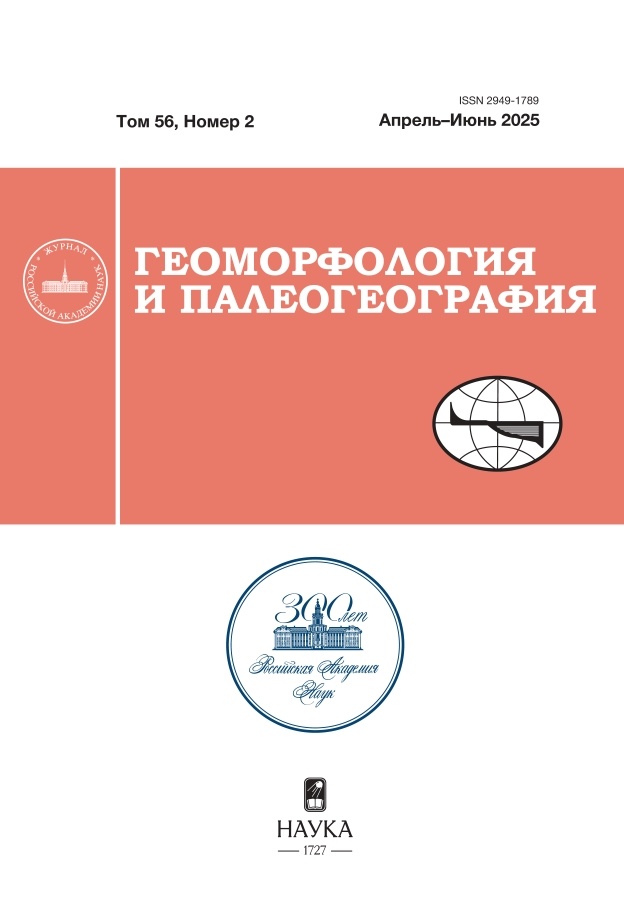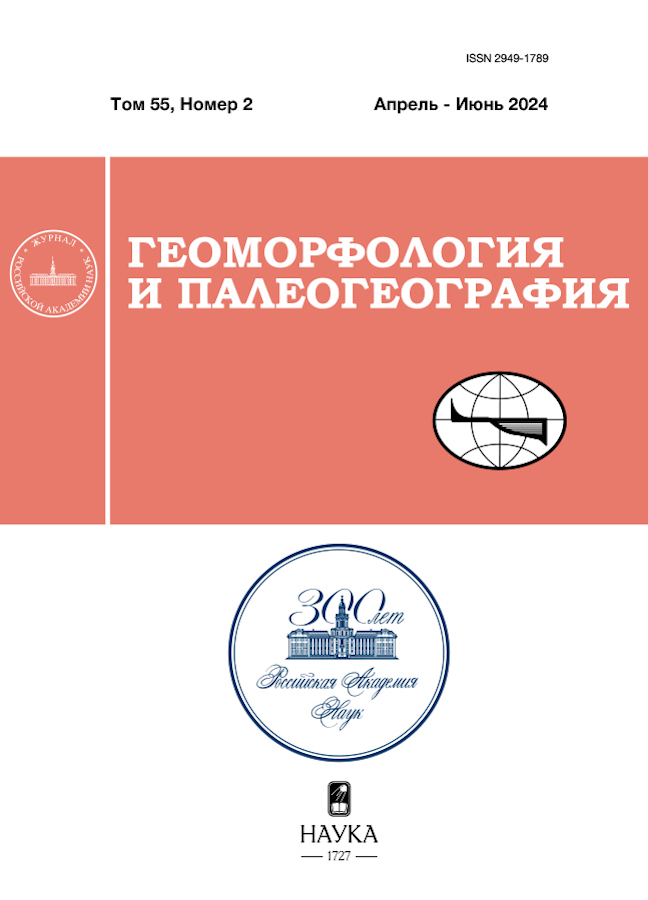Пещеры в слабокарстующихся породах Алтае-Саянской горной области: механизм формирования и морфология
- Авторы: Булычов А.А.1
-
Учреждения:
- Институт геологии и минералогии имени академика В. С. Соболева СО РАН
- Выпуск: Том 55, № 2 (2024)
- Страницы: 108—125
- Раздел: НАУЧНЫЕ СООБЩЕНИЯ
- URL: https://medjrf.com/2949-1789/article/view/660714
- DOI: https://doi.org/10.31857/S2949178924020057
- EDN: https://elibrary.ru/PNWOME
- ID: 660714
Цитировать
Полный текст
Аннотация
Помимо многочисленных подземных полостей, связанных с процессами растворения карбонатных пород, в пределах Алтае-Саянской горной области имеется целый ряд пещер, развитых в некарстующихся и слабокарстующихся породах. Среди них своими размерами выделяются пещеры конгломератовой нарвской толщи Баджейского массива (Восточный Саян, Манский прогиб). Самыми выдающимися пещерами здесь являются Большая Орешная, Дудинская и Баджейская, длина составляет более 50 км, 35 км и 10 км соответственно. Известняки среднегорья Алтая часто контактируют с эффузивными и интрузивными породами и изменены в пределах контактовых зон метаморфизма до плотных мраморизованных пород, что делает невозможным протекание карстовых процессов. Тем не менее в мраморизованных известняках нижнего кембрия каянчинской свиты Горного Алтая развиты крупные пещеры Алтайская и Кёк-Таш общей протяженностью 4.7 и 3.2 км соответственно.
Детальное картографирование пещер, развитых в некарстующихся и слабокарстующихся породах, показало их тесную пространственную связь с системами новейших разрывных нарушений. В пещерах по зонам разломов обнаружены признаки повсеместной аргиллизации (изменение исходного вещества гидротермальными процессами и замещение его новообразованными глинистыми минералами). Предлагаемый нами механизм формирования пещер в некарстующихся и слабокарстующихся породах сводится к выносу грунтовыми водами аргиллизированного гидротермальными процессами по зонам разломов субстрата без существенного участия растворения (карстовых процессов). Это роднит данный механизм с хорошо известным процессом “глинистого карста”, связанного с суффозией в глинистых породах. Отличие сводится к развитию изученных нами форм и процессов в аргиллизированных разломных зонах, а не в глинистых толщах.
Полный текст
Открыть статью на сайте журналаОб авторах
А. А. Булычов
Институт геологии и минералогии имени академика В. С. Соболева СО РАН
Автор, ответственный за переписку.
Email: bulychovanatoli@yandex.ru
Россия, Новосибирск
Список литературы
- Апродов В. А. (1952). Геологическое картирование. М.: Госгеолиздат. 371 с.
- Атлас пещер России. (2019). Под ред. А. Л. Шелепина, Б. А. Вахрушева, А. А. Гунько и др. М.: РГО, РСС. 768 с.
- Булычов А. А. (1990). Крупнейшие пещеры Горного Алтая. В сб.: Пещеры. Вып. 22. Пермь: ПГУ. С. 140.
- Булычов А. А. (2019). Многогранная подготовка спортивного спелеотуриста. В сб.: Пещеры. Вып. 42. Пермь: ПГУ. C. 101—110.
- Волостных Г. Т. (1972). Аргиллизация и оруденение. М.: Недра. 240 с.
- Гвоздецкий Н. А. (1954). Карст. Вопросы общего и регионального карстоведения. М.: Географгиз. 352 с.
- Геологическая карта западной части Алтае-Саянской горной области. (1977). Под ред. В. И. Коновалова, В. И. Зиновьева, А. В. Пешковой. Л.: Аэрогеология. 6 л.
- Геологическая карта СССР масштаба 1:200 000, серия Восточно-Саянская, лист N-46-X. Объяснительная записка. (1962). Под ред. А. А. Предтеченского. М.: Госгеолтехиздат, 1962. 80 с.
- Гинзбург И. И. (1963). Типы древних кор выветривания, форма их проявления и классификация. В сб.: Кора выветривания. Вып. 6. М.: АН СССР. C. 71—101.
- Дублянский Ю. В. (1987). Геологические условия формирования и моделирование гидротермокарста. Дис. … канд. геол.-мин. наук. Новосибирск: ИГиГ СОАН СССР. 185 с.
- Зверева Е. А., Писемский Г. В. (1969). Кора выветривания на массивах ультраосновных щелочных пород и карбонатитов. Серия Геология месторождений редких элементов. Вып. 34. М.: Недра. 203 с.
- Каждан А. Б., Гуськов О. И. (1990). Математические методы в геологии. Учебник для вузов. М.: Недра. 251 с.
- Казицин Ю. В. (1979). Метасоматизм в земной коре. Л.: Недра. 208 с.
- Катаев В. Н. (1999). Теория и методология структурно-тектонического анализа в карстоведении. Дис. … докт. геол.-мин. наук. Пермь: ПГУ. 451 с.
- Климчук А. Б. (2009). Эпикарст: гидрогеология, морфогенез и эволюция. Симферополь: Сонат. 112 с.
- Корин И. З. (1960). Роль трещинных структур в формировании месторождений гипергенного генезиса. В сб.: Проблемы тектонофизики. М.: Госгеолтехиздат. С. 162—167.
- Макаров В. Н. (1965). Минералогия осадочных руд Яковлевского месторождения КМА и особенности их хлоритизации. Автореф. дис. … канд. геол.-мин. наук. Днепропетровск: Днепропетровский горный институт имени Артема. 19 с.
- Макаров В. Н. (1967). Минерал из группы сванбергита в коре выветривания Яковлевского месторождения КМА. В сб.: Записки Всесоюзного минералогического общества. Т. 96. Вып. 3. С. 342—345.
- Максимов Г. М. (1993а). Карст и пещеры центра Горного Алтая. В сб.: Свет. Вестник Киевского Карстолого-спелеологического Центра. № 4 (10). С. 20—22.
- Максимов Г. М. (1993б). Крупнейшие пещеры и шахты Алтая (Восточная Сибирь). В сб.: Свет. Вестник Киевского карстолого-спелеологического центра. № 4 (10). С. 13—19.
- Максимович Г. А. (1963). Основы карстоведения. Т. 1. Пермь: Пермское книжное изд-во. 446 с.
- Маринин А. М. (1990). Карст и пещеры Алтая: учебно-краеведческое пособие. Новосибирск: НГПИ. 148 с.
- Мейер Ч., Хемли Д. (1970). Околорудные изменения вмещающих пород. В сб.: Геохимия гидротермальных рудных месторождений. М.: Мир. С. 148—210.
- Михайлов Н. И. (1961). Горы Южной Сибири. М.: Географгиз. 243 с.
- Мягков В. Ф. (1984). Математические методы в геологии. Методическая разработка. Свердловск: Свердловский горный институт. 44 с.
- Новиков И. С. (1998). Роль тектоники в эволюции рельефа Горного Алтая. Геоморфология. № 1. С. 82—91.
- Новиков И. С., Дядьков П. Г., Козлова М. П. и др. (2014). Неотектоника и сейсмичность западной части Алтае-Саянской горной области, Джунгарской впадины и Китайского Тянь-Шаня. Геология и геофизика. Т. 55. № 12. С. 1802—1814.
- Новиков И. С., Жимулев Ф. И., Ветров Е. В. и др. (2019). Геологическая история и рельеф северо-западной части Алтае-Саянской области в мезозое и кайнозое. Геология и геофизика. Т. 60. № 7. С. 988—1003. https://doi.org/10.15372/RGG2019054
- Разумова В. Н. (1977). Древние коры выветривания и гидротермальный процесс: М.: Наука. 156 с.
- Разумова В. Н., Херасков Н. П. (1963). Геологические типы кор выветривания и закономерности их размещения. В сб.: Геологические типы кор выветривания и примеры их распространения на Южном Урале. Труды ГИН АН СССР. Вып.77. М.: Наука. С. 5—34.
- Расулов Ш. К. (1967). Петрография гранитоидных пород Зиаэтдинских гор и их продуктов коры выветривания. Автореф. дис. … канд. геол.-мин. наук. Ташкент. 26 с.
- Тащилкин В. А. (1969). Коры выветривания Приморья. Автореф. дис. … канд. геол.-мин. наук. М.: МГУ. 24 с.
- Токарев В. Н., Юрьев А. А. Косякова Л. Н., Глаас Г. А. (2019). Государственная геологическая карта Российской Федерации масштаба 1:200 000. Издание второе. Серия Кузбасская. Лист N-45-XXI (Прокопьевск). Объяснительная записка. СПб.: Картографическая фабрика ВСЕГЕИ. 210 с.
- Фурман И. Я. (1957). К проблеме геохимии углерода. В сб.: Труды Воронежского университета. Т. 58. С. 59—66.
- Херасков Н. П. (1958). Роль тектоники в изучении закономерностей размещения различных полезных ископаемых в земной коре. В сб.: Закономерности размещения полезных ископаемых. Т. 1. М.: АН СССР. С. 14—91.
- Херасков Н. П. (1963). Некоторые общие закономерности в строении и развитии структуры земной коры. М.: АН СССР. 122 с.
- Цыкин Р. А. (1985). Отложения и полезные ископаемые карста. Новосибирск: Наука. 165 с.
- Цыкин Р. А. (1990). Карст Сибири. Красноярск: КГУ. 154 с.
- Шахов Ф. Н. (1964). Геология жильных месторождений. М.: Наука. 244 с.
- Boulytchov A. A. (1999). Kektash — the deepest cave of Siberia and Big Oreshnaya — the longest one. Stalactite. Bern, Switzerland. № 49. 1. P. 47—48.
- Boulytchov A. A. (2000). Seismic-electric effect method on guided and reflected waves. Physics and Chemistry of the Earth. J. of EGS. Oxford-Amsterdam: Elsevier. V. 25. № 4. P. 333—336.
- Bulychov A. A., Sorokina T. V. (2017). Multi-faceted training of caver-explorer. Proceedings of the 17th International Congress of Speleology. Sydney, Australia. V. 1. P. 278—284.
- Cardarelli E., Cercato M., Cerreto A. et al. (2010). Electrical resistivity and seismic refraction tomography to detect buried cavities. Geophysical Prospecting. V. 58. № 4. P. 685—695. https://doi.org/10.1111/j.1365-2478.2009.00854.x.
- Ford D., Williams P. (2007). Karst geomorphology and hydrogeology. England: Chichester. 562p.
- Golicz M. (2017). Caveink — a set of Inkscape extensions for drawing cave maps. Proceedings of the 17th International Congress of Speleology. Sydney, Australia. V. 2. P. 111—115.
- Hellstrom J. (2017). Three-dimensional cave mapping using Structure from Motion. Proceedings of the 17th International Congress of Speleology. Sydney, Australia. V. 2. P. 116.
- Kempe S., Bauer I. (2017). 3D-imaging as a tool to understand speleogenetic processes. Proceedings of the 17th International Congress of Speleology. Sydney, Australia. V. 2. P. 117—121.
- Klimchouk A. B. (2007). Hypogene speleogenesis: hydrogeological and morphogenetic perspective. National Cave and Karst Researxh Institute. Special paper № 1. Carlsbad. 106 p.
- Lipar M., Ferk M. (2022). Fluviokarst on Quaternary eogenetic conglomerates; an example from Slovenia. Proceedings of the 18th International Congress of Speleology. Savoie Mont-Blanc, France. V. 4. Geomorphology. P. 57—60.
- Lovering T. S., Shepard A. O. (1960). Hydrothermal argillic alteration on the Helen Claim, East District, Utah. Clays and clay minerals. 8th Nat. Conference. Pergamon Press. Р. 40—52.
- Mikhailov O. V., Haartsen M. W., Toksoz M. N. (1997). Electroseismic investigation of the shallow subsurface: field measurements and numerical modeling. Geophysics. 62. № 1. P. 97—105.
- Mitchell E. J., Mitchell J. N. (2017). Comparison of shallow geophysical cave detection methods to 3D Lidar mapping. Proceedings of the 17th International Congress of Speleology. Sydney, Australia. V. 2. P. 126—129.
- Novikov I. S., Sokol E. V. (2007). Combustion metamorphic events as age markers of orogenic movements in Central Asia. Acta Petrologica Sinica. V. 23. № 7. P. 1561—1572. https://doi.org/10000-0569/2007/023(07)-1561-72
- Quinif Y., Verheyden S. (2022). Ghost-rock karstification. Proceedings of the 18th International Congress of Speleology. Savoie Mont-Blanc, France. V. 4. Geomorphology. P. 227—230.
- Sorokina T. V., Boulytchov A. A. (2001). Seismic-electric benchmarking of shallow subsurface horizons and dome cavities. Proceedings of the International Conference of EAGE. Amsterdam, Netherlands. V. 2. P. 133—136.
Дополнительные файлы





















